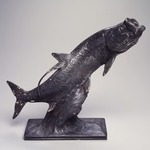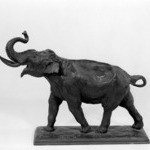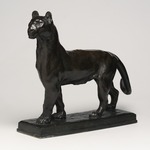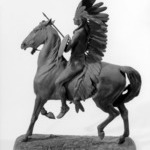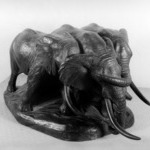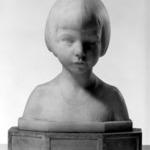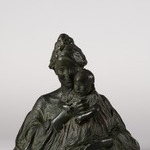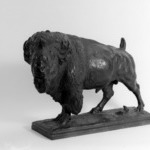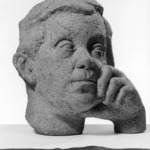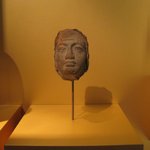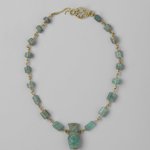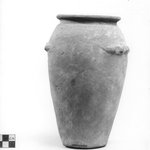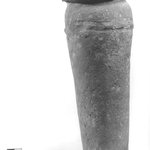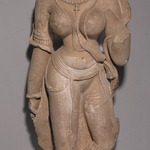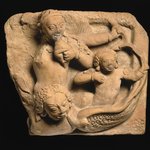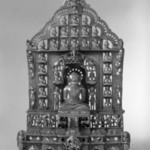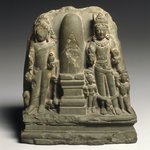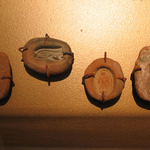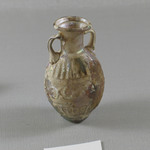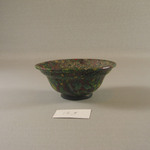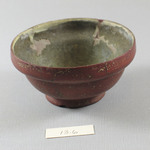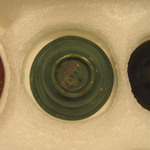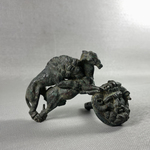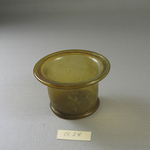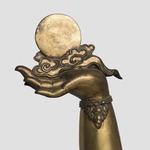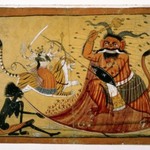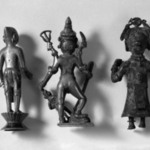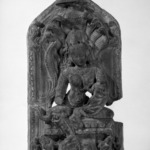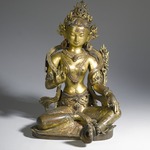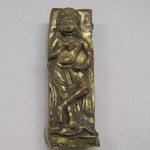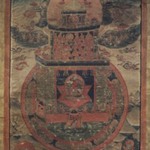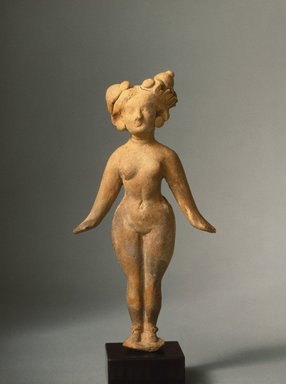
Standing Female
Asian Art
On View: Asian Galleries, Arts of South Asia, 2nd floor
Long before they made icons of Hindu or Buddhist deities, the artists of India created images of gods and goddesses that appear to have been associated with fertility and abundance. The identities of these deities are unknown—it is likely that they were called by many different names—but their representations share several features, most notably well-fed, voluptuous bodies and abundant jewelry. Most of the images of these deities are small, formed from clay, and were probably worshipped on domestic shrines or used as amulets. The female figures far outnumber the male.
These clay figurines appear in a wide variety of styles, reflecting differences in the tastes and modeling abilities of various regions and periods. This lively female figure comes from an area of Pakistan where merchants from around the Mediterranean had long maintained trading posts. The area, known in antiquity as Gandhara, developed an unusual hybrid style of art and culture that was at once Hellenic and Indic. The face and upper torso of this figure resemble those on terracotta images from the classical world, while her wide hips and ornate coiffure are more typical of Indian fertility goddesses.
These clay figurines appear in a wide variety of styles, reflecting differences in the tastes and modeling abilities of various regions and periods. This lively female figure comes from an area of Pakistan where merchants from around the Mediterranean had long maintained trading posts. The area, known in antiquity as Gandhara, developed an unusual hybrid style of art and culture that was at once Hellenic and Indic. The face and upper torso of this figure resemble those on terracotta images from the classical world, while her wide hips and ornate coiffure are more typical of Indian fertility goddesses.
MEDIUM
Terracotta
GEOGRAPHICAL LOCATIONS
- Possible place made: Charsadda, Pakistan
- Possible place made: Sirkap, Pakistan
DATES
1st century C.E.
PERIOD
Kushan Period
DIMENSIONS
overall (without base): 7 x 3 5/8 x 1 1/2 in. (17.8 x 9.2 x 3.8 cm) (show scale)



COLLECTIONS
Asian Art
ACCESSION NUMBER
88.194
CREDIT LINE
Gift of Georgia and Michael de Havenon
CATALOGUE DESCRIPTION
Red terracotta, hand-modeled and molded.
Female figure standing on a round flat base with her feet together. She is nude except for an elaborate headdress consisting of flowers and a water pot at her left, and she is adorned with earplugs and anklets. Her face is molded but her torso is hand-molded with high round breasts, a narrow waist, ample hips and thighs. A long braid hangs to get lower back. Her arms are held straight out to either side beside her hips.
Other similar terracotta figurines have been unearthed in the region of Taxila, particularly at Sirkap, which was excavated and published by Sir John Marshall cf. reports of the 1913-1934 excavation reports, in Taxila (Cambridge, 1951) Vol. III, pl. 132, torsos numbers 6-9, and pl. 133, heads, numbers 4648.
The figure arrived with its own black base.
Conditions: Left arm below elbows is a plaster restoration. Otherwise condition is excellent.
EXHIBITIONS
MUSEUM LOCATION
This item is on view in Asian Galleries, Arts of South Asia, 2nd floor
CAPTION
Taxila. Standing Female, 1st century C.E. Terracotta, overall (without base): 7 x 3 5/8 x 1 1/2 in. (17.8 x 9.2 x 3.8 cm). Brooklyn Museum, Gift of Georgia and Michael de Havenon, 88.194. Creative Commons-BY (Photo: Brooklyn Museum, 88.194_SL1.jpg)
IMAGE
overall, 88.194_SL1.jpg. Brooklyn Museum photograph
"CUR" at the beginning of an image file name means that the image was created by a curatorial staff member. These study images may be digital point-and-shoot photographs, when we don\'t yet have high-quality studio photography, or they may be scans of older negatives, slides, or photographic prints, providing historical documentation of the object.
RIGHTS STATEMENT
Creative Commons-BY
You may download and use Brooklyn Museum images of this three-dimensional work in accordance with a Creative Commons license. Fair use, as understood under the United States Copyright Act, may also apply.
Please include caption information from this page and credit the Brooklyn Museum. If you need a high resolution file, please fill out our online application form (charges apply).
For further information about copyright, we recommend resources at the United States Library of Congress, Cornell University, Copyright and Cultural Institutions: Guidelines for U.S. Libraries, Archives, and Museums, and Copyright Watch.
For more information about the Museum's rights project, including how rights types are assigned, please see our blog posts on copyright.
If you have any information regarding this work and rights to it, please contact copyright@brooklynmuseum.org.
RECORD COMPLETENESS
Not every record you will find here is complete. More information is available for some works than for others, and some entries have been updated more recently. Records are frequently reviewed and revised, and we welcome any additional information you might have.
